Related Research Articles

The ionosphere is the ionized part of the upper atmosphere of Earth, from about 48 km (30 mi) to 965 km (600 mi) above sea level, a region that includes the thermosphere and parts of the mesosphere and exosphere. The ionosphere is ionized by solar radiation. It plays an important role in atmospheric electricity and forms the inner edge of the magnetosphere. It has practical importance because, among other functions, it influences radio propagation to distant places on Earth. It also affects GPS signals that travel through this layer.

Space weather is a branch of space physics and aeronomy, or heliophysics, concerned with the varying conditions within the Solar System and its heliosphere. This includes the effects of the solar wind, especially on the Earth's magnetosphere, ionosphere, thermosphere, and exosphere. Though physically distinct, space weather is analogous to the terrestrial weather of Earth's atmosphere. The term "space weather" was first used in the 1950s and popularized in the 1990s. Later, it prompted research into "space climate", the large-scale and long-term patterns of space weather.
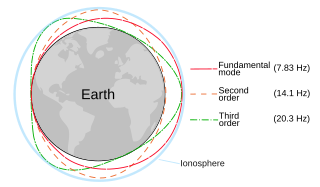
The Schumann resonances (SR) are a set of spectrum peaks in the extremely low frequency portion of the Earth's electromagnetic field spectrum. Schumann resonances are global electromagnetic resonances, generated and excited by lightning discharges in the cavity formed by the Earth's surface and the ionosphere.
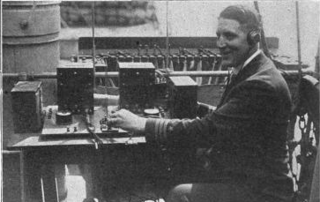
Ultra low frequency (ULF) is the ITU designation for the frequency range of electromagnetic waves between 300 hertz and 3 kilohertz, corresponding to wavelengths between 1,000 to 100 km. In magnetosphere science and seismology, alternative definitions are usually given, including ranges from 1 mHz to 100 Hz, 1 mHz to 1 Hz, and 10 mHz to 10 Hz.
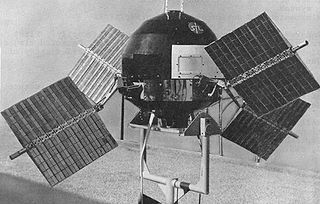
Explorer 6, or S-2, was a NASA satellite, launched on 7 August 1959, at 14:24:20 GMT. It was a small, spheroidal satellite designed to study trapped radiation of various energies, galactic cosmic rays, geomagnetism, radio propagation in the upper atmosphere, and the flux of micrometeorites. It also tested a scanning device designed for photographing the Earth's cloud cover. On 14 August 1959, Explorer 6 took the first photos of Earth from a satellite.

Astérix or A-1 is the first French satellite. It was launched on 26 November 1965 by a Diamant A rocket from the CIEES launch site at Hammaguir, Algeria. With Astérix, France became the sixth country to have an artificial satellite and the third country to launch a satellite on its own rocket. Its main purpose was to test the Diamant launcher, though it was also designed to study the ionosphere. Astérix continues to orbit Earth as of 2023 and is expected to remain in orbit for centuries.
Dynamics Explorer was a NASA mission, launched on 3 August 1981, and terminated on 28 February 1991. It consisted of two unmanned satellites, DE-1 and DE-2, whose purpose was to investigate the interactions between plasmas in the magnetosphere and those in the ionosphere. The two satellites were launched together into polar coplanar orbits, which allowed them to simultaneously observe the upper and lower parts of the atmosphere.
Astrionics is the science and technology of the development and application of electronic systems, subsystems, and components used in spacecraft. The electronic systems on-board a spacecraft are embedded systems and include attitude determination and control, communications, command and telemetry, and computer systems. Sensors refers to the electronic components on board a spacecraft.

Explorer 54, also called as AE-D, was a NASA scientific satellite belonging to series Atmosphere Explorer, being launched on 6 October 1975 from Vandenberg Air Force Base board a Thor-Delta 2910 launch vehicle.
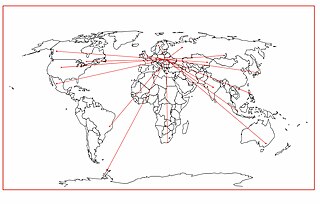
The Lviv Centre of Institute for Space Research, is a research institute in Lviv, Ukraine. It falls under the purview of the NASU and NSAU,.
Seismo-electromagnetics are various electro-magnetic phenomena believed to be generated by tectonic forces acting on the Earth's crust, and possibly associated with seismic activity such as earthquakes and volcanoes. Study of these has been prompted by the prospect they might be generated by the increased stress leading up to an earthquake, and might thereby provide a basis for short-term earthquake prediction. However, despite many studies, no form of seismo-electromagnetics has been shown to be effective for earthquake prediction. A key problem is that earthquakes themselves produce relatively weak electromagnetic phenomena, and the effects from any precursory phenomena are likely to be too weak to measure. Close monitoring of the Parkfield earthquake revealed no significant pre-seismic electromagnetic effects. However, some researchers remain optimistic, and searches for seismo-electromagnetic earthquake precursors continue.
TARANIS was an observation satellite of the French Space Agency (CNES) which would have studied the transient events produced in the Earth's atmospheric layer between 10 km (6.2 mi) and 100 km (62 mi) altitude. TARANIS was launched in November 2020 with SEOSat-Ingenio aboard Vega flight VV17 and would have been placed in a Sun-synchronous orbit at an altitude of 676 km, for a mission duration of two to four years, but the rocket failed shortly after launch.
CSES , or Zhangheng, is a Chinese–Italian space mission dedicated to monitoring electromagnetic field and waves, plasma parameters and particle fluxes induced by natural sources and artificial emitters in the near-Earth space. Austria contributes to one of the magnetometers.

Explorer 22 was a small NASA ionospheric research satellite launched 9 October 1964, part of NASA's Explorer Program. It was instrumented with an electrostatic probe, four radio beacons for ionospheric research, a passive laser tracking reflector, and two radio beacons for Doppler navigation experiments. Its objective was to provide enhanced geodetic measurements of the Earth as well as data on the total electron content in the Earth's atmosphere and in the satellite's immediate vicinity.

Explorer 51, also called as AE-C, was a NASA scientific satellite belonging to series Atmosphere Explorer, being launched on 16 December 1973, at 06:18:00 UTC, from Vandenberg board a Delta 1900 launch vehicle.

Elektron ('electron'), in American sources sometimes called Electron, was the first Soviet multiple satellite program, comprising two identical pairs of particle physics satellites launched by the Soviet Union in 1964. The four spacecraft simultaneously monitored the lower and upper Van Allen radiation belts and returned a considerable volume of data regarding radiation in space and atmospheric conditions to an altitude of more than 58,000 kilometres (36,000 mi) above the Earth. Two of the four launched satellites are still in orbit As of 2023, the other two having reentered.
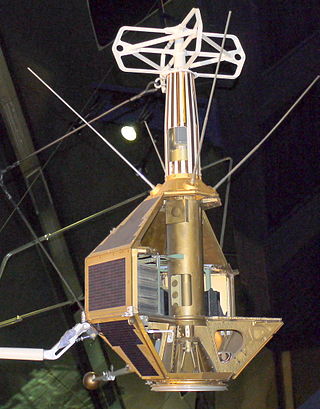
FR-1 was the second French satellite. Planned as the first French satellite, it was launched on 6 December 1965—ten days after the actual first French satellite, Astérix—by an American Scout X-4 rocket from the Western Range at Vandenberg Air Force Base. The scientific satellite studied the composition and structure of the ionosphere, plasmasphere, and magnetosphere by measuring the propagation of very low frequency (VLF) waves and the electron density of plasma in those portions of the Earth's atmosphere. FR-1's VLF receiver operated until 26 August 1968. FR-1 remains in orbit as of 2023.

Orbiting Vehicle 2-5, the third and last satellite of the second series of the United States Air Force's Orbiting Vehicle program, was an American particle science and ionosphere research satellite. Launched 26 September 1968 along with three other satellites, OV2-5 became the first scientific satellite to operate at geosynchronous altitude.

Dynamics Explorer 1 was a NASA high-altitude mission, launched on 3 August 1981, and terminated on 28 February 1991. It consisted of two satellites, DE-1 and DE-2, whose purpose was to investigate the interactions between plasmas in the magnetosphere and those in the ionosphere. The two satellites were launched together into polar coplanar orbits, which allowed them to simultaneously observe the upper and lower parts of the atmosphere.

Dynamics Explorer 2 was a NASA low-altitude mission, launched on 3 August 1981. It consisted of two satellites, DE-1 and DE-2, whose purpose was to investigate the interactions between plasmas in the magnetosphere and those in the ionosphere. The two satellites were launched together into polar coplanar orbits, which allowed them to simultaneously observe the upper and lower parts of the atmosphere.
References
- ↑ Lagoutte et al. "The DEMETER Science Mission Centre". Planetary and Space Science 54 (2006) 428-440.
- ↑ Athanasiou, M. A.; Anagnostopoulos, G. C.; Iliopoulos, A. C.; Pavlos, G. P.; David, C. N. (11 April 2011). "Enhanced ULF radiation observed by DEMETER two months around the strong 2010 Haiti earthquake". Natural Hazards and Earth System Sciences. 11 (4): 1091–1098. arXiv: 1012.1533 . Bibcode:2011NHESS..11.1091A. doi: 10.5194/nhess-11-1091-2011 . S2CID 53456663.
- ↑ Zlotnicki, Jacques; Li, Feng; Parrot, Michel (2013). "Ionospheric Disturbances Recorded by DEMETER Satellite over Active Volcanoes: From August 2004 to December 2010" (PDF). International Journal of Geophysics. 2013: 1–17. doi: 10.1155/2013/530865 .
- ↑ "DEMETER DATA SERVER".